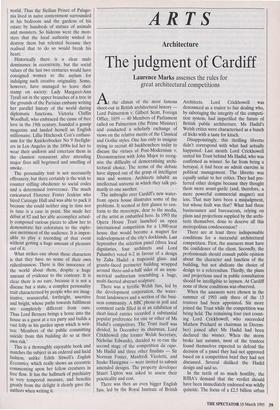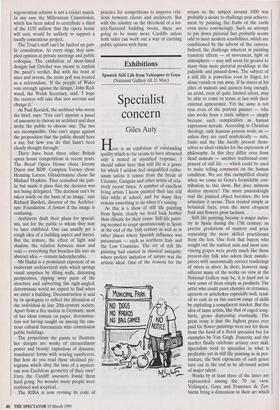ARTS
Architecture
The judgment of Cardiff
Laurence Marks assesses the rules for great architectural competitions Athe climax of the most famous shoot-out in British architectural history Lord Palmerston v. Gilbert Scott, Foreign Office, 1859 — 40 Members of Parliament called on Palmerston (the Prime Minister) and conducted a scholarly exchange of views on the relative merits of the Classical and Gothic styles. One has only to imagine trying to recruit 40 backbenchers today to discuss the virtues of Post-Modernism v. Deconstruction with John Major to recog- nise the difficulty of democratising archi- tectural choice. The terms of the debate have slipped out of the grasp of intelligent men and women. Architects inhabit an intellectual universe in which they talk pri- marily to one another. The imbroglio over Cardiff's new water- front opera house illustrates some of the problems. It seemed at first glance to con- form to the stereotype, dear to the media, of the artist as embattled hero. In 1993 the Opera House Trust launched an open international competition for a 1,900-seat house that would become a magnet for redevelopment of the city's docklands. Last September the selection panel (three local dignitaries, four architects and Lord Palumbo) voted 6-2 in favour of a design by Zaha Hadid: a trapezoid glass- and granite-faced perimeter building wrapped around three-and-a-half sides of an asym- metrical auditorium resembling a huge, multi-faceted abstract sculpture.
There was a terrific Welsh fuss, led by the development corporation, the water- front landowners and a section of the busi- ness community. A BBC phone-in poll and comment cards filled in at an exhibition of short-listed entries recorded a substantial popular preference for one or other of Ms Hadid's competitors. The Trust itself was divided. In December its chairman, Lord Crickhowell (the former Welsh Secretary, Nicholas Edwards), decided to re-run the second stage of the competition da capo. Ms Hadid and three other finalists — Sir Norman Foster, Manfredi Vicoletti, and Itsuko Hasegawa — were invited to submit amended designs. The property developer Stuart Lipton was asked to assess their practicality and cost.
There was then an even bigger English fuss, led by the Royal Institute of British Architects. Lord Crickhowell was denounced as a traitor to fair dealing who, by sabotaging the integrity of the competi- tion system, had imperilled the future of British public architecture. Ms Hadid's Welsh critics were characterised as a bunch of hicks with a taste for kitsch.
Disappointingly, this thrilling libretto didn't correspond with what had actually happened. Last month Lord Crickhowell united his Trust behind Ms Hadid, who was confirmed as winner. So far from being a betrayal, it had been an adroit exercise in political management. The libretto was equally unfair to her critics. They had pre- ferred other designs because they thought them more avant-garde (and, therefore, a more powerful commercial magnet) not less. That may have been a misjudgment, but whose fault was that? What had these businessmen and bureaucrats, relying on plans and projections supplied by the archi- tects themselves, done to deserve all this metropolitan condescension?
There are at least three indispensable conditions for a successful architectural competition. First, the assessors must have the confidence of the client. Secondly, the professionals should consult public opinion about the character and function of the building, but not abdicate the choice of design to a referendum. Thirdly, the plans and projections used in public consultation should be intelligible to laymen. At Cardiff none of these conditions was observed.
When the assessors were chosen in the summer of 1993 only three of the 13 trustees had been appointed. Six more joined the Trust while the competition was being held. The remaining four (not count- ing Lord Crickhowell, who succeeded Mathew Prichard as chairman in Decem- ber) joined after Ms Hadid had been declared the winner. When the storm broke last autumn, most of the trustees found themselves expected to defend the decision of a panel they had not approved based on a competition brief they had not discussed. Several disliked the Hadid design and said so.
In the teeth of so much hostility, the RIBA's demand that the verdict should have been immediately endorsed was wildly quixotic. The focus of a £2.5 billion urban regeneration scheme is not a cricket match. In any case the Millennium Commission, which has been asked to contribute a third of the £150 million that the opera house will cost, would be unlikely to support a locally contentious project.
The Trust's staff can't be faulted on pub- lic consultation. At every stage they sam- pled opinion at private meetings and public colloquia. The exhibition of short-listed designs last October was meant to explain the panel's verdict. But with the trust at sixes and sevens, the straw poll was treated as a referendum. 'If the people of Wales vote strongly against the design,' John Red- wood, the Welsh Secretary, said, 'I hope the trustees will take that into account and change it.'
As Paul Koralek, the architect who wrote the brief, says: 'You can't appoint a panel of assessors to choose an architect and then invite the public to choose one. The two are incompatible. One can't argue against the proposition that the public should have a say, but how you do that hasn't been clearly thought through.'
There have been three other British opera house competitions in recent years. The Royal' Opera House chose Jeremy Dixon and BDP. Compton Verney chose Henning Larsen. Glyndebourne chose Sir Michael Hopkins. They consulted the pub- lic but made it plain that the decision was not being delegated. 'The decision can't be taken solely on the basis of an image,' says Richard Burdett, director of the Architec- ture Foundation. A fortiori if the image is confusing.
Architects draft their plans for special- ists, not for the public to whom they may be later exhibited. One can usually get a rough idea of a building aspect and layout. But the texture, the effect of light and shadow, the relation between mass and void — everything that breathes life into an abstract idea — remain indecipherable.
Ms Hadid is a prominent exponent of an exuberant architectural style which springs visual surprises by tilting walls, distorting perspectives, ripping away parts of the structure and subverting the right-angled, determinate world we expect to find when we enter a building. Deconstruction is said by its apologists to reflect the alienation of the individual in late 20th-century society. Apart from a fire station in Germany, most of her ideas remain on paper, deconstruc- tion not having caught on among the cau- tious cultural bureaucrats who commission public buildings.
The projections she paints to illustrate her designs are works of extraordinary power and beauty: explosions of dynamic, translucent forms with soaring cantilevers. But how do you read these idealised pic- tograms which obey the laws of a mysteri- ous non-Euclidean geometry of their own? Even the Cardiff assessors found them hard going. No wonder many people were confused and sceptical.
The RIBA is now revising its code of practice for competitions to improve rela- tions between clients and architects. But with the country on the threshold of a lot- tery-financed building boom, there are going to be many more Cardiffs unless both sides can work out a way of carrying public opinion with them.



























































 Previous page
Previous page